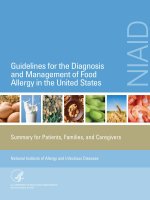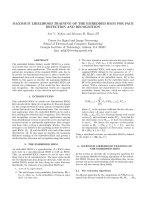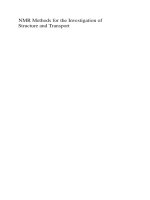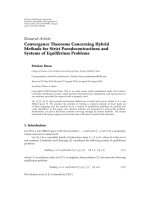Statistical methods for the detection and analyses of structural variants in the human genome
Bạn đang xem bản rút gọn của tài liệu. Xem và tải ngay bản đầy đủ của tài liệu tại đây (6.33 MB, 171 trang )
STATISTICAL METHODS FOR THE
DETECTION AND ANALYSES
OF STRUCTURAL VARIANTS IN THE HUMAN GENOME
TEO SHU MEI
NATIONAL UNIVERSITY OF SINGAPORE
KAROLINSKA INSTITUTET
2012
STATISTICAL METHODS FOR THE
DETECTION AND ANALYSES
OF STRUCTURAL VARIANTS IN THE HUMAN GENOME
TEO SHU MEI
A THESIS SUBMITTED
FOR THE DEGREE OF DOCTOR OF PHILOSOPHY
NUS GRADUATE SCHOOL FOR INTEGRATIVE SCIENCES AND ENGINEERING
NATIONAL UNIVERSITY OF SINGAPORE
SAW SWEE HOCK SCHOOL OF PUBLIC HEALTH
NATIONAL UNIVERSITY OF SINGAPORE
DEPARTMENT OF MEDICAL EPIDEMIOLOGY AND BIOSTATISTICS
KAROLINSKA INSTITUTET
STOCKHOLM, SWEDEN
2012
Declaration
I hereby declare that the thesis is my original work
and it has been written by me in its entirety. I have
duly acknowledged all the sources of information
which have been used in the thesis.
This thesis has also not been submitted for any
degree in any university previously.
_________________
Teo Shu Mei
26 Nov 2012
SUMMARY
Structural variations (SVs) are an important and abundant source of variation in the
human genome, encompassing a greater proportion of the genome as compared to
single nucleotide polymorphisms (SNPs). This thesis investigates different aspects of
SV analysis, focusing on copy number variations (CNVs) and regions of homozygosity
(ROHs). It is divided into four main studies, each focusing on a different set of aims.
In Study I, Identification of recurrent regions of copy-number variation across multiple
individuals, we develop an algorithm and software to identify common CNV regions
using individually segmented data. The identified common regions allow us to
investigate population characteristics of CNVs, as well as to perform association
studies.
In Study II, Multi-platform segmentation for joint detection of copy number variants,
we develop an algorithm to identify CNVs using intensity data from more than one
platform. The algorithm is useful when researchers have data from multiple platforms
on the same individual.
In Study III, Regions of homozygosity in three Southeast-Asian populations, we identify
ROHs in three Singapore populations, namely the Chinese, Malays and Indians. We
characterize the regions and provide population summary statistics. We also investigate
the relationship between the occurrence of ROHs and haplotype frequency, regional
linkage disequilibrium (LD) and positive selection. The results show that frequency of
occurrence of ROHs is positively associated with haplotype frequency and regional
LD. The majority of regions detected for recent positive selection and regions with
differential LD between populations overlap with the ROH loci. When we consider
both the location of the ROHs and the allelic form of the ROHs, we are able to separate
the populations by principal component analysis, demonstrating that ROHs contain
information on population structure and the demographic history of a population.
Last but not least, in Study IV, Statistical challenges associated with detecting copy
number variants with next-generation sequencing technology, we describe and discuss
areas of potential biases in CNV detection for each of four commonly used methods. In
particular, we focus on issues pertaining to (1) mappability, (2) GC-content bias, (3)
quality-control measures of reads, and (4) difficulties in identifying duplications. To
gain insights to some of the issues discussed, we download real data from the 1000
Genomes Project and analyze it in terms of depth of coverage (DOC). We show
examples of how reads in repeated regions can affect CNV detection, demonstrate
current GC correction algorithms, investigate sensitivity of DOC algorithm before and
after quality-control of reads and discuss reasons for which duplications are harder to
detect than deletions.
1
PREFACE
I first started dabbling with genetic data during my 4
th
year as a Statistics
undergraduate in 2007. I was working on the Affymetrix 500K SNP array, one of the
densest SNP microarrays at that time. Barely 5 years later, there are arrays with more
than 5 million SNPs, not to mention Next-generation sequencing arrays that produce
billions of reads in a single run. The technologies to study genetics have certainly
evolved very rapidly, bringing with it new challenges in terms of statistical and
bioinformatics analyses.
When I first learnt of the term „CNV‟, the concept sounded simple to me: That we
have regions of the genome that are deleted/duplicated, and that based on the intensity
of our measurements, less intense means less of that particular region, and vice versa.
“Not too complex!” I thought naively. As I continue to learn more, the multitude of
problems/challenges that comes associated with the analysis of noise-rich CNV data
is enormous. As put across aptly by John Ioannidis on genetic data from microarrays
in general, “…this noise is so data-rich that minimum, subtle, and unconscious
manipulation can generate spurious “significant” biological findings that withstand
validations by the best scientists, in the best journals. Biomedical science would then
be entrenched in some ultramodern middle ages, where tons of noise is accepted as
“knowledge”. – The Lancet 365: 454-455.
Nevertheless, I hope that with these four years of hard work, I have helped made a
little more sense out of the massive amount of genetic data we have.
2
LIST OF PUBLICATIONS
This thesis is based on the following original articles which will be referred to in the
text by their Roman numerals.
I. Teo SM, Salim A, Calza S, Ku CS, Chia KS, Pawitan Y. (2010) Identification
of recurrent regions of copy number variation across multiple individuals.
BMC Bioinformatics 11:147.
II. Teo SM, Pawitan Y, Kumar V, Thalamuthu A, Seielstad M, Chia KS, Salim
A. (2011) Multi-platform Segmentation for joint detection of copy number
variants. Bioinformatics 27:11.
III. Teo SM, Ku CS, Salim A, Naidoo N, Chia KS, Pawitan Y. (2012) Regions of
homozygosity in three Southeast Asian populations. Journal of Human
Genetics 57: 101-108.
IV. Teo SM, Pawitan Y, Ku CS, Chia KS, Salim A. Statistical challenges
associated with detecting copy number variants with next-generation
sequencing technology. Manuscript.
Other relevant publications:
Teo SM, Ku CS, Naidoo N, Hall P, Chia KS, Salim A, Pawitan Y. (2011) A
population-based study of copy number variants and regions of homozygosity
in healthy Swedish individuals. Journal of Human Genetics 56:524-533.
Ku CS, Teo SM, Naidoo N, Sim X, Teo YY, Pawitan Y, Seielstad M, Chia
KS, Salim A. (2011) Copy number polymorphisms in new HapMap III and
Singapore populations. Journal of Human Genetics 56:552-560.
Ku CS, Naidoo N, Teo SM, Pawitan Y. (2011) Regions of homozygosity and
their impact on complex diseases and traits. Human Genetics 129:1-15.
Ku CS, Naidoo N, Teo SM, Pawitan Y. (2011) Characterising Structural
Variation by Means of Next-Generation Sequencing. Encyclopedia of Life
Sciences (ELS). John Wiley & Sons, Ltd: Chichester.
3
TABLE OF CONTENTS
LIST OF TABLES 5
LIST OF FIGURES 6
LIST OF ABBREVIATIONS 8
CHAPTER 1 – INTRODUCTION 10
CHAPTER 2 – BACKGROUND 13
2.1 TERMINOLOGY AND NOMENCLATURE 13
2.2 CNV AND ROH DETECTION TECHNOLOGIES 16
2.3 CNV AND ROH DETECTION ALGORITHMS 17
2.4 SEQUENCING TECHNOLOGIES 19
2.4.1 First generation sequencing 19
2.4.2 Next-generation sequencing (NGS) 19
2.4.3 CNV detection using NGS 20
Depth of coverage 21
Paired-end mapping 22
Split-read 22
Assembly-based 23
2.5 REPETITIVE DNA 23
2.6 COPY NUMBER VARIATION REGION (CNVR) 24
2.7 HARDY WEINBERG EQUILIBRIUM OF CNVR 25
2.8 GWAS OF CNVS 26
2.9 LINKAGE DISEQUILIBRIUM 27
2.10 QUANTIFICATION OF POSITIVE SELECTION 27
CHAPTER 3 – AIMS 29
CHAPTER 4 - PAPER SUMMARIES 30
4.1 STUDY I: IDENTIFICATION OF RECURRENT REGIONS OF COPY-NUMBER VARIATION
ACROSS MULTIPLE INDIVIDUALS. 30
4.1.1 Motivation 30
4.1.2 Methods overview 30
Method 1: Cumulative Overlap Using Very Reliable Regions (COVER) 31
Method 2: Cumulative Composite Confidence Scores (COMPOSITE) 31
4
Method 3: Clustering of Individual CNV regions within a Common Region . 31
4.1.3 Results 32
Comparison with sequenced regions 32
Comparison to other algorithms 33
Implementation 33
4.2 STUDY II: MULTI-PLATFORM SEGMENTATION FOR JOINT DETECTION OF COPY
NUMBER VARIANTS. 34
4.2.1 Motivation 34
4.2.2 Methods overview 35
4.2.3 Results 36
Implementation 37
4.3 STUDY III: REGIONS OF HOMOZYGOSITY (ROHS) IN THREE SOUTHEAST ASIAN
POPULATIONS 39
4.3.1 Motivation 39
4.3.2 Samples 40
4.3.3 Results 40
4.4 STUDY IV: STATISTICAL CHALLENGES ASSOCIATED WITH DETECTING CNVS
USING NEXT-GENERATION SEQUENCING (NGS) TECHNOLOGY. 42
4.4.1 Motivation 42
4.4.2 Results 42
CHAPTER 5 - DISCUSSION 43
5.1 WHAT MAKES A GOOD CNV DETECTION METHOD? 43
5.2 CONCORDANCES AMONG CNV DETECTION METHODS 43
5.3 PROBLEMS CAUSED BY REPETITIVE DNA 45
5.4 A PEEK INTO THIRD GENERATION SEQUENCING (TGS) 47
CHAPTER 6 - CONCLUSIONS 49
CHAPTER 7 – FUTURE DIRECTIONS AND PERSPECTIVES 50
ACKNOWLEDGEMENTS 52
REFERENCES 54
5
LIST OF TABLES
Table 2.1: Definition of the different classes of genetic variations, partly adapted from
Figure 1 of Scherer et al., 2007. *only selected types of variation are defined.
Table 2.2: This table summarises for each repeat class, the repeat type (tandem or
interspersed), number in the hg19 human genome, percentage of the hg19 human
genome covered, and approximate lower and upper bounds for the lengths of the
repeat. (Table adapted from Treangen et al., 2012). Short interspersed nuclear
elements (SINEs), Long terminal repeat (LTR), Long interspersed nuclear elements
(LINEs), ribosomal DNA (rDNA).
Table 4.1: Haplotype frequencies of three populations in an ROH that overlaps
VKORC1 gene (from Teo et al., 2012).
6
LIST OF FIGURES
Figure 2.1: C-T single nucleotide variation.Source:
Figure 2.2: Schematic and simplified diagram of a deletion and duplication (adapted
from Ku et al., 2010).
Figure 2.3: (Left panel) ROH signature with LRR around zero and no clusters at BAF
of 0.5. (Right panel) One copy deletion signature with decreased LRR and similar
pattern of BAF as ROH. The x-axis is the genomic probe location and each point
represents a probe in the SNP array. (Figure from Ku et al., 2011).
Figure 2.4: Figure from Wang et al., 2007, illustrating the unique patterns in LRR and
BAF of the different copy number states. A „normal copy‟ has three BAF clusters and
the LRR is centred around zero; a ROH has LRR centred around zero but only two
clusters at both extremes of the BAF.
Figure 2.5: Schematic diagram illustrating the concept of depth of coverage method
for CNV detection. If the sample has an additional copy relative to the reference
genome, when the reads are mapped to the reference, we would observe an increase
in depth of coverage in the region.
Figure 4.1: An example of a CNVR identified by COVER. We observe that despite
being identified as a common region, the individual regions still portray a mixture
phenomenon of several distinct sub-regions (from Teo et al., 2010).
Figure 4.2: (a) Discordance rates for COVER method decreases as the confidence
score thresholds increase. (b) Rates of departure from HWE decreases as the
confidence score thresholds increase (from Teo et al., 2010).
Figure 4.3: Examples of segments detected by the multiplatform methods. (a) A
deletion in Chromosome 8. Single platform smoothseg on Illumina platform was
unable to identify the deletion due to lack of probes in the region. Single platform
smoothseg on Affymetrix platform was unable to identify the deletion due to
insufficient signal. (b) A deletion in Chromosome 16. Single platform smoothseg on
Affymetrix platform was unable to identify the deletion due to complete lack of
probes in the region. (c) A deletion in Chromosome 22 (from Teo et al., 2011).
Figure 4.4: The number of overlapping bases as a proportion of Conrad's CNVs and
as a proportion of each method's CNVs; the different points for each method
correspond to the different thresholds. A higher proportion of overlap indicates better
performance (from Teo et al., 2011).
7
Figure 5.1: Diagram illustrating the non-triviality of determining if two CNVs are the
„same‟ variant. In (a), CNV1 and CNV2 overlap completely. In this case, we are
confident that the two CNVs are the same. In (b), the start and end positions of CNV1
and CNV2 differs, but there is substantial overlap between the two. In (c), CNV1 is
completely within the range of CNV2 but the two CNVs differ vastly in lengths. In
most research papers, scientists are comfortable with using a 50% reciprocal overlap
to determine if two CNVs are concordant.
8
LIST OF ABBREVIATIONS
The following abbreviations have been used in this thesis and in the associated four
original publications:
aCGH
AIC
ANOVA
AS
BAF
Bp
CAHRES
CBS
COMPOSITE
COVER
CNV
CNVR
DGV
DNA
DOC
EHH
FDR
GWAS
HIV
HMM
HTS
HWE
iHS
kb
LD
LINEs
LOH
LRR
Array comparative genomic hybridization
Akaike information criterion
Analysis of variance
Assembly based
B allele frequency
Base-pairs
Cancer Hormone Replacement Epidemiology in Sweden
Circular Binary Segmentation
Cumulative Overlap Using Very Reliable Regions
Cumulative Composite Confidence Scores
Copy number variation
Copy number variation region
Database of Genomic Variants
Deoxyribonucleic acid
Depth of coverage
Extended haplotype homozygosity
False discovery rate
Genome-wide association studies
Human immunodeficiency virus
Hidden Markov model
High throughput sequencing
Hardy Weinberg equilibrium
Integrated haplotype score
Kilo base-pairs
Linkage disequilibrium
Long interspersed nuclear elements
Loss of homozygosity
Log R ratio
9
LTR
MAF
MPSS
MPCBS
NGS
PEM
PCA
PCR
QC
RD
rDNA
RP
ROH
SINEs
SOLiD
SMS
SNP
SR
SV
TGS
VKORC1
VNTR
WTCCC
Long terminal repeat
Minor allele frequency
Multi-platform smooth segmentation
Multiple platform circular binary segmentation
Next-generation sequencing
Paired end mapping
Principal component analysis
Polymerase chain reaction
Quality-control
Read depth
Ribosomal deoxyribonucleic acid
Read pair
Regions of homozygosity
Short interspersed nuclear elements
Supported Oligonucletide Ligation Detection System
Single molecule sequencing
Single-nucleotide polymorphism
Split read
Structural variants
Third generation sequencing
Vitamin K epoxide reductase complex subunit 1
Variable number of tandem repeats
Wellcome Trust Case Control Consortium
10
Chapter 1 – INTRODUCTION
Genetic variation in the human genome can take many forms, including single-
nucleotide polymorphisms (SNPs), copy number variations (CNVs), indels, regions
of homozygosity (ROHs), and other structural variants (SVs). In the last couple of
years, genome-wide association studies (GWAS) have been widely used to correlate
genetic differences to phenotypic variation, but they were largely focused on SNPs.
CNVs and other SVs were less appreciated until two landmark studies in 2004
identified widespread deletions and duplications in the human genome (Sebat et al.,
2004; Iafrate et al., 2004). By now, CNVs are widely recognized as a prevalent form
of variation in the genome, encompassing a greater proportion of the genome as
compared to SNPs. An estimated 1.2% of a single genome differs from the reference
human genome when considering CNVs, as compared to 0.1% by SNPs (Pang et al.,
2010). Recent studies have found CNVs to be associated with complex diseases such
as human immunodeficiency virus (HIV) infection, cancer, diabetes, mental disorders,
obesity, Parkinson‟s disease and autoimmune diseases (Wain et al., 2009; The
Wellcome Trust Case Control Consortium 2010). ROHs are also more abundant than
previously thought (Gibson et al., 2006), and are associated with complex diseases
such as schizophrenia and late-onset Alzheimer‟s disease (Lencz et al., 2007; Nalls et
al., 2009).
That, as compared to SNPs, the association of CNVs and ROHs with complex
diseases is not as well-studied is in part due to greater complexity in identifying these
multi-base, multi-allelic variants, and also greater complexity in performing
11
association studies with these variants. Early works on CNVs/ROHs have focused
largely on identifying and characterizing regions in the genome which harbour them.
This has been necessary in laying the foundation to improve our understanding of
CNVs/ROHs for subsequent association analysis with human complex diseases.
The most common technologies for CNVs identification in the last couple of years are
high density SNP arrays and array comparative genomic hybridization (aCGH) arrays;
the former (SNP arrays) are also commonly used for detection of ROHs. However,
the data generated from these techniques are noisy, and identifying CNVs
comprehensively with high resolution still remains a technical and statistical
challenge. aCGH and SNP arrays are also limited by the resolution of the array to
determine precise locations of CNV breakpoints, and are unable to locate copy-
neutral events such as inversions and translocations.
Sanger sequencing, often seen as the gold standard for CNV detection, is able to
detect CNVs with higher accuracy and resolution, to detect balanced rearrangements
such as inversions and translocations, as well as to detect CNVs in regions where
probe density of other platforms is low. However, the technique is not feasible for a
large number of genomes due to time and budget constraints. Next-generation
sequencing (NGS) attempts to combine the benefits of array technology and
sequencing. The biggest advantage of NGS over traditional Sanger sequencing is the
ability to sequence millions of reads in a single run at a comparatively inexpensive
cost (Metzker, 2010). However, with billions of reads generated per individual, there
is an increasing need for more bioinformatics support and computers with larger
storage and higher computing powers, and for such support to keep pace with the
12
rapidly changing technologies. Already, there is a great demand for information
technology infrastructure and bioinformatics team to analyse the massive amount of
data, with speculations that the costs associated with down-handling, storing and
analysis of the data could be more than the production of the data.
There is still a need for the development of new statistical/bioinformatics methods
and software for the systematic analysis of CNV/SV data. This is the focus of this
thesis.
13
Chapter 2 – BACKGROUND
In this chapter, I will introduce some concepts in CNV/ROH analysis, including
definitions and introduction to existing technology, software and algorithms in
detection of CNV/ROH. These will facilitate the understanding of subsequent
chapters.
2.1 Terminology and nomenclature
Human genetic variations refer to differences in the deoxyribonucleic acid (DNA)
sequences among different individuals; they can take many forms, including single-
nucleotide polymorphisms (SNPs), indels, copy number variations (CNVs), and other
copy-neutral variations such as inversions, translocations and regions of
homozygosity (ROHs). These genetic variations span a spectrum of sizes, ranging
from 1 base-pair (bp) changes to whole chromosomal changes (e.g. aneuploidy). The
occurrences of these genetic variations are attributed to different diverse mechanisms.
For example, the predominant mechanisms for CNV formation include non-allelic
homologous recombination and non-homologous end joining (Hastings et al., 2009;
Conrad et al., 2010). ROHs are thought to be a result of autozygosity or uniparental
isodisomy (Gibson et al., 2006).
Table 2.1 summarizes the definitions of variants from single base changes to the sub-
microscopic level (larger variants are not discussed). Note that the definitions for the
different classes of genetic variants based on size are often unclear at the edges of
each class. For example, larger indels may sometimes be termed CNVs even when
their sizes are less than 1 kb.
14
Types of variation
Size
Definition*
Remarks
SNVs, SNPs,
single-nucleotide
insertions-
deletions (indels)
1 bp
SNVs are variations of
a single nucleotide (see
Figure 1). When the
variation is common
(usually defined as
having a frequency of
more than 1%), we call
it a SNP (Figure 2.1).
Most SNPs are single
nucleotide substitutions,
although single nucleotide
deletions/insertions may
also fall under this category.
Indels,
microsatellites,
minisatellites,
inversions, di-,tri-
tetranucleatide
repeats, variable
number of tandem
repeats (VNTRs)
2 to < 1000
bp
Indels are typically
defined as insertions or
deletions that are
smaller than 1 kb and
larger than 1 bp.
The size cut off is rather
arbitrary; Database of
Genomic Variants (DGV)
defines indels in the size
range of 100 bp to 1 kb.
CNVs, segmental
duplications,
inversions,
translocations
1000 bp to
sub-
microscopic
CNVs are additions or
deletions in the number
of copies of a segment
of DNA (larger than 1
kb in length) when
compared to a
reference genome
(Figure 2.2).
Some large indels larger
than 500 bp may also be
termed CNVs. Common
CNV larger than 1%
population frequency are
termed copy number
polymorphism (CNP).
ROHs
> 500 bp
ROHs are continuous
stretches of the genome
(usually more than 500
kb) without
heterozygosity in the
diploid state.
Table 2.1: Definition of the different classes of genetic variations, partly adapted from
Figure 1 of Scherer et al., 2007. *only selected types of variation are defined.
15
Figure 2.1: C-T single nucleotide variation.Source:
Figure 2.2: Schematic and simplified diagram of a deletion and duplication (adapted
from Ku et al., 2010).
ROHs are sometimes termed loss of homozygosity (LOH), which includes
hemizygous deletions (where there is only one copy of the region). Genotypes of
SNPs within hemizygous deletions may be erroneously called as homozygous
resulting in a region that may seem to be a ROH based on SNP genotypes alone.
Figure 2.3 illustrates the differences in intensity patterns for ROH and one-copy
deletion; while both ROH and one-copy deletion have similar B allele frequency
(BAF) patterns, the Log R ratio (LRR) for ROH is around zero while it is below zero
16
for one-copy deletion. In this thesis, ROH always refer to the copy-neutral variant,
where the region is in diploid state and all bases within the region are homozygous.
Figure 2.3: (Left panel) ROH signature with LRR around zero and no clusters at BAF
of 0.5. (Right panel) One copy deletion signature with decreased LRR and similar
pattern of BAF as ROH. The x-axis is the genomic probe location and each point
represents a probe in the SNP array. (Figure from Ku et al., 2011).
2.2 CNV and ROH detection technologies
In the last decade or so, the most commonly used technologies for CNV detection are
whole-genome array comparative genome hybridization (aCGH) and high-density
SNP arrays. ROHs are typically detected using high-density SNP arrays.
CNVs/ROHs detected using these technologies are unfortunately limited by the
density of the probes, as well as the location of the probes. For example, array
platforms with more than 1 million probes have a lower detection limit of 10-25 kb in
the size of CNV (McCarroll et al., 2008). Sanger sequencing provides better
resolution and accuracy, but it is not cost/time-effective to use on a genome-wide
scale for many individuals. The recent development of next generation sequencing
(NGS) platforms that allow massive parallel sequencing have the potential to discover
17
smaller CNVs that were not previously discovered, detect balanced rearrangements
such as inversions and translocations, as well as detect rare CNVs for which SNP
arrays have no probes for. The biggest advantage over traditional Sanger sequencing
is the ability to produce large amount of sequencing data in a single run.
However, as compared to SNPs, detection of CNVs is more challenging because of its
complexity as a multi-base, multi-allelic variant. As a result, different algorithms and
methods often give vastly different estimates in the number and breakpoints of CNVs.
Currently, in the Database of Genomic Variants (DGV), there are more than 130,000
(merged) CNVs from 37 different studies, encompassing more than 52% of the
genome; a likely gross overestimation of the true percentage of the genome
encompassed by CNVs. This is because all the different studies use a heterogonous
array of technologies, algorithms, filtering parameters, and samples.
2.3 CNV and ROH detection algorithms
Detection of CNVs from aCGH arrays is mostly based on locating change-points in
intensity-ratio patterns that would partition each chromosome into several discrete
segments. On the other hand, the hidden Markov model (HMM) is particularly
popular for detection of CNVs from SNP arrays, where the hidden states provide a
natural way of combining information from the total signal intensity (known as log R
ratio, LRR) and the relative allele frequency (known as B allele frequency, BAF)
values. Briefly, the HMM assumes several possible hidden states such as „deletion‟,
„normal‟, „region of homozygosity‟ and „duplication‟ and analyse the most possible
state-transition path, assuming that the copy numbers of nearby SNPs are dependent
18
(Wang et al., 2007). Illustrated in Figure 2.4, a „normal copy‟ has three BAF clusters
and the LRR is centred around zero; a ROH has LRR centred around zero but only
two clusters at both extremes of the BAF.
The output from a CNV detection algorithm provides the following information: (1)
Chromosome number (2) Start location (3) End location (4) Copy number. For
example, this is a typical output from PennCNV:
chr6:32565228-32593190 numsnp=30 "length=27,963" "state1,cn=0"
It tells us that in Chromosome 6 of this individual, from the position 32565228 to
position 32593190, there is a deletion where this individual has zero copies as
compared to the reference panel. There are 30 probes in this region in the platform
used, and the length of the region is 27,963 bases.
Figure 2.4: Figure from Wang et al., 2007, illustrating the unique patterns in LRR and
BAF of the different copy number states. A „normal copy‟ has three BAF clusters and
the LRR is centred around zero; a ROH has LRR centred around zero but only two
clusters at both extremes of the BAF.
19
2.4 Sequencing technologies
2.4.1 First generation sequencing
First generation sequencing is typically referred to as „Sanger sequencing‟, and is
introduced by Frederick Sanger in 1977 (Sanger, 1977). It is the main form of
sequencing technique used over the last 30 years until the arrival of next-generation
sequencers in 2005. Sanger sequencing is able to sequence reads of length ~ 800-
1000 bases (Hert et al., 2008; Schloss et al., 2008; Venter et al., 2001).
However, Sanger sequencing is laborious and costly; its inability to process more than
96 sequence reads at a time limits its application to large scale genome-wide
sequencing efforts for many individuals (Mardis, 2008). For example, it took nearly
ten years and three billion dollars to sequence the first human genome in the Human
Genome Project (Schadt et al., 2010).
2.4.2 Next-generation sequencing (NGS)
Next-generation sequencing (NGS) or also known as high-throughput sequencing
(HTS) is able to simultaneously sequence millions of DNA reads. This ability to
produce large amount of sequencing data in a single run at a comparatively
inexpensive cost is its biggest advantage over traditional Sanger sequencing (Metzker,
2010). Currently available NGS sequencers in the market include the Roche 454
Genome Sequencer FLX System, Illumina Genome Analyzer, Illumina HiSeq and
Applied Biosystems‟ Supported Oligonucletide Ligation Detection System (SOLiD).
20
NGS has the potential to discover smaller CNVs that were not previously discovered,
to detect balanced rearrangements such as inversions and translocations, as well as to
detect CNVs in regions where probe density of other platforms, such as SNP arrays,
is low. NGS technologies have facilitated and accelerated the process of identifying
genetic variations through whole-genome re-sequencing projects, including the 1000
Genomes Project.
However, there are some technical features of NGS that result in several challenges.
Firstly, due to an effect called „dephasing‟, there is an increase in noise and
sequencing errors as the read length extends, thereby limiting the read lengths of NGS
to ~35 – 400 bases (Schadt et al., 2010). The short read lengths in turn complicate
alignment and assembly. Secondly, in order to generate a large number of DNA
molecules, polymerase chain reaction (PCR) amplification is required. This
amplification process biases the frequency in which different portions of the genome
are sequenced (Schadt et al., 2010).
2.4.3 CNV detection using NGS
Broadly, there are four complementary methods for CNV detection using NGS data,
namely (1) depth of coverage (DOC, also known as read-depth (RD) methods), (2)
paired-end mapping (PEM), (3) split-read (SR) and (4) assembly-based (AS) methods
(Alkan et al., 2011). Except for the latter, the other three classes of methods require
first mapping the sequenced reads to a known reference genome. The different
methods are usually complementary to one another as the underlying concepts excel
21
at detecting certain types of variants, and a large proportion of discovered variants
remain unique to a particular approach (Alkan et al., 2011).
Some algorithms use a combination of methods for more accurate detection of CNVs.
For example, CNVer supplements DOC with PEM information in a unified
framework (Medvedev et al., 2010). Genome STRiP combines information from
DOC, PEM, SR as well as other features of sequence data at population level
(Handsaker et al., 2011). Genome STRiP is one of the highest performing method
used in the 1000 Genomes pilot Project, indicating that there is benefit in combining
different approaches (Mills et al., 2011).
Depth of coverage
DOC methods typically count the number of reads that fall in each pre-specified
window of a certain size (Abyzov et al., 2011; Yoon et al., 2009). The underlying
concept of identifying CNVs using DOC is similar is that of using intensity data: a
lower than expected DOC /intensity indicates deletion and a higher than expected
DOC /intensity indicates duplication (Figure 2.5). The algorithm relies heavily on the
assumption that the sequencing process is uniform, i.e., the number of reads mapping
to a region is proportional to the number of copies. However, certain biases such as
GC-content and mappability cause this assumption to be unrealistic; regions of the
genome may be over or under-sampled regardless of the copy number of the region,
often resulting in spurious signals. DOC algorithms usually detect large CNVs and
are unable to detect copy neutral events such as inversions and translocations. Single-
end or paired-end data may be used for this analysis.









